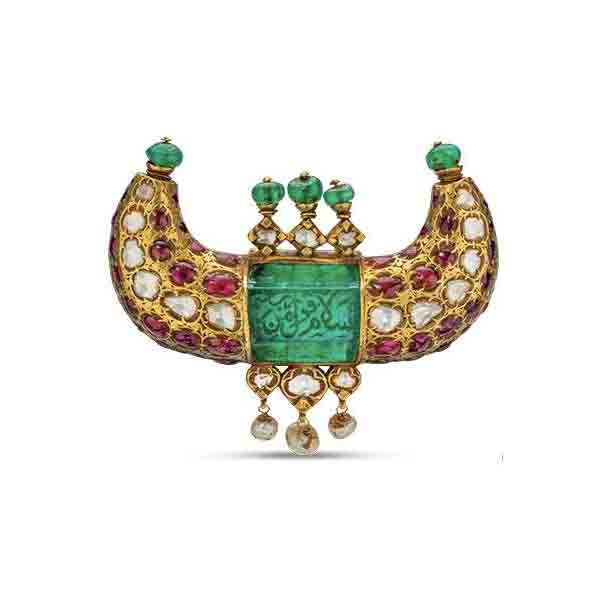
Ever since my first trip to India in 2004, I’ve been enamored with the Indian jewelry tradition. I’ve returned to the country three times, but my last visit was nearly a decade ago. This week, I’m headed back to the country—this time, to Jaipur, capital of Rajasthan state, to attend the International Colored Gemstone Association (ICA) biannual congress, which runs Oct. 21–24.
I’ll be in the legendary Pink City until the morning of Oct. 26, when my boyfriend, Jim, and I will fly to Udaipur, another city in Rajasthan, and finally, on to Pushkar for the annual camel fair, a spectacle I’ve had my heart set on seeing for more than a decade.
The universe seems to be in on the plan. Last week, I had the pleasure of attending the opening of GIA’s new museum exhibition at its world headquarters in Carlsbad, Calif. Lo and behold, it was the perfect appetizer for my trip: 50 exquisite jewels and objects from India on loan from a private collection.
The pieces on display span more than 300 years of adornment from the 17th to the 20th centuries, including a number of jeweled relics from the Mughal empire (1526–1857), which extended across the north of India and beyond, and the Vijayanagar empire (1346-1646) in the south of India. The parade of finery is remarkable for the simple reason that it exists. Unlike most Indian jewels from the past, and especially jewels intended for brides, which were dismantled and melted down so the new bride was not affected by the karma associated with the old jewelry, these pieces have improbably survived. And the story they tell us about Indian culture is magnificent.
“The jewelry of the Islamic north was colorful and beautifully constructed, with bright enameled gold on both front and back,” writes Tsajon von Lixfield in the foreword to the book that accompanies the exhibition. “The Mughal rulers spared no cost in creating and maintaining royal ateliers with the finest artisans. The symbolism of their designs was in keeping with Islamic tradition, using images such as the crescent, flowers, and birds, as well as verses from the Koran, engraved in fine gems. In the Hindu south, there was more emphasis on gold weight and images of their gods carved out of colored gems.”
As a rule, Indian royals sought the finest examples of every gem, including diamonds from the mythical mines of Golconda, emeralds from the Muzo mine in Colombia, sapphires from Ceylon (now Sri Lanka), and rubies and spinels from Afghanistan, Tajikistan, and the Mogok region of Burma (now Myanmar).
Consider the Mughal-era gold horn pendant below. Made for a ruler of the Kingdom of Mysore, it is centered on a stunning 125-ct. Colombian emerald that’s been engraved with salutations of peace in Arabic.
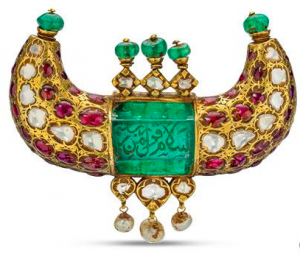
Mughal era gold horn pendant with 125 ct. Colombian emerald, diamonds, Burmese rubies, emerald beads, and pearls (photo by Robert Weldon/GIA)
Below, you’ll see a small selection of the jewels on display at GIA. If you’re anywhere near Carlsbad between now and March 1, don’t miss the opportunity to see these pieces in person. Their sheer size (and presumably, weight) will astound you. Huge congrats to GIA Museum curator Terri Ottaway and exhibit designer McKenzie Santimer for putting together such a fantastic exhibition!
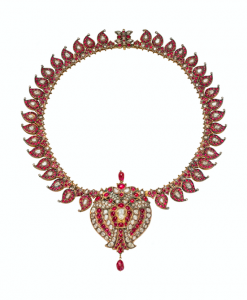
Royal manga mala necklace in 22k gold with elaborate repoussé detailing on the back, diamonds, rubies, and emeralds (photo by Robert Weldon/GIA)
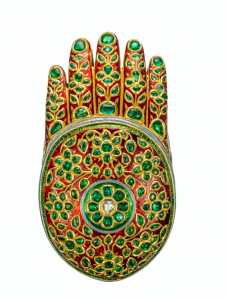
Hand of Vishnu Hindu ritual artifact in enameled 22k gold with emeralds and diamonds, engraved in Sanskrit on the back with devotional verses from the Bhagavad Gita in praise of Lord Krishna (photo by Robert Weldon/GIA)
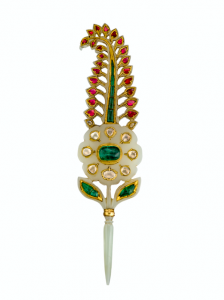
Mughal jade turban ornament, designed to be tucked into the folds at the front of the turban, in white jade, also known as “mutton fat” jade, with diamonds, spinels, and emeralds in 22k gold (photo by Robert Weldon/GIA)

Mughal necklace and earrings in 22k gold with approximately 150 cts. t.w. Golconda diamonds and 47 Colombian emerald beads (photo by Robert Weldon/GIA)
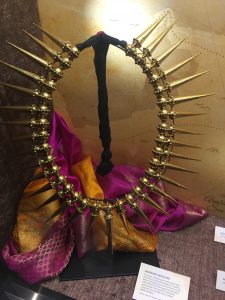
Marriage necklace composed of 33 hollow gold stylized spiky jasmine buds, typical of the Nair community in Kerala, South India
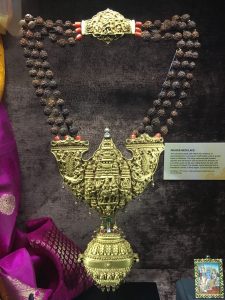
Prayer necklace in repoussé 22k gold on strand of rudraksha seeds
I’ll restate the obvious: No country on earth boasts a jewelry culture older or more entrenched than India’s. For lovers of gems, there is simply no better place to appreciate the history, value, and significance of stones or the elaborate jewels that incorporate them. My next two posts will be devoted to what I learn at the ICA Congress and what I see in my travels around Rajasthan. Stay tuned!
Follow JCK on Instagram: @jckmagazineFollow JCK on Twitter: @jckmagazine
Follow JCK on Facebook: @jckmagazine